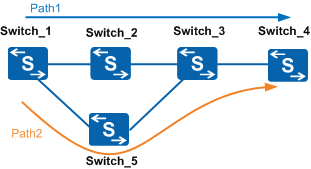Make-Before-Break
The make-before-break mechanism prevents traffic loss during a traffic switchover between two CR-LSPs. This mechanism improves MPLS TE tunnel reliability.
Background
Any change in link or tunnel attributes causes a CR-LSP to be reestablished using new attributes. Traffic is then switched from the previous CR-LSP to the new CR-LSP. If a traffic switchover is triggered before the new CR-LSP is set up, some traffic is lost. The make-before-break mechanism prevents traffic loss.
Implementation
The make-before-break mechanism sets up a new CR-LSP and switches traffic to it before the original CR-LSP is torn down. This mechanism helps minimize data loss and reduces bandwidth consumption. Make-before-break is implemented using the shared explicit (SE) resource reservation style.
The new CR-LSP may compete with the original CR-LSP for bandwidth on some shared links. The new CR-LSP cannot be established if it fails the competition. The make-before-break mechanism allows the system to reserve bandwidth used by the original CR-LSP for the new one, without calculating the reserved bandwidth on shared links. Additional bandwidth is required if links on the new path do not overlap the links on the original path.
In Figure 1, the maximum reservable bandwidth on each link is 60 Mbit/s. A CR-LSP has been set up along Path 1 (Switch_1 -> Switch_2 -> Switch_3 -> Switch_4) with the bandwidth of 40 Mbit/s.
A new CR-LSP needs to be set up along Path 2 (Switch_1 -> Switch_5 -> Switch_3 -> Switch_4) to forward data through the lightly loaded Switch_5. The available bandwidth of the link Switch_3 -> Switch_4 is only 20 Mbit/s, not enough for the new path. The make-before-break mechanism can be used in this situation to allow the new CR-LSP to use the bandwidth of the link between Switch_3 and Switch_4 reserved for the original CR-LSP. After the new CR-LSP is established, traffic switches to the new CR-LSP, and the original CR-LSP is torn down.
The make-before-break mechanism can also be used to increase tunnel bandwidth. If the reservable bandwidth of a shared link increases to the required value, a new CR-LSP can be established.
On the network shown in Figure 1, the maximum reservable bandwidth on each link is 60 Mbit/s. A CR-LSP has been set up along Path 1 with the bandwidth of 30 Mbit/s.
A new CR-LSP needs to be set up along Path 2 to forward data through the lightly loaded Switch_5, and the path bandwidth needs to increase to 40 Mbit/s. The available bandwidth of the link Switch_3 -> Switch_4 is only 30 Mbit/s. The make-before-break mechanism can be used in this situation. This mechanism allows the new CR-LSP to use the bandwidth of the link between Switch_3 and Switch_4 reserved for the original CR-LSP, and reserves an additional bandwidth of 10 Mbit/s for the new path. After the new CR-LSP is set up, traffic is switched to the new CR-LSP, and the original CR-LSP is torn down.
Switching and Deletion Delays
If a node is busy but its upstream or downstream node is idle, a CR-LSP may be torn down before a new CR-LSP is established, causing a temporary traffic interruption.
The make-before-break mechanism uses switching and deletion delay timers to prevent temporary traffic interruption. When the two timers are configured, the system switches traffic to a new CR-LSP after the switching delay time, and then deletes the original CR-LSP after the deletion delay time.
